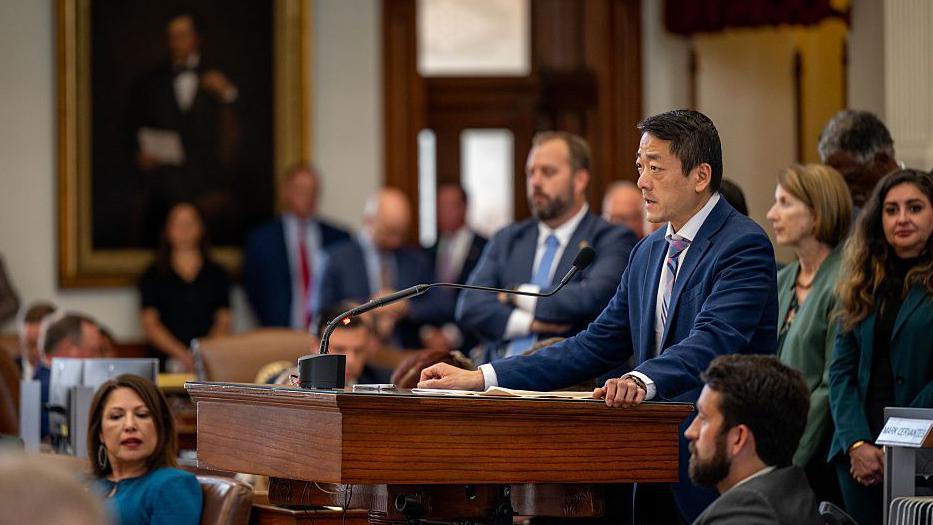Indiana joins growing US battle over redrawing electoral maps

- Published
Indiana has become the latest battleground in a growing national clash over redistricting, as Republicans and Democrats race to redraw congressional maps to alter the balance of power in Washington.
Lawmakers in California and Texas, the two most populous US states with a combined population of over 70 million, have already approved redistricting lines that favour one political party.
Now Indiana has joined the fray. After President Donald Trump put pressure on Republican governors nationwide, leaders in the state have called a special session to redraw congressional boundaries, set for December.
In a twist, a Utah judge has ordered that state Republicans must use a map likely to favour Democrats.
The political tug-of-war over redrawing electoral maps is likely to intensify, with both parties seeking any edge ahead of the 2026 midterms.
Here's what you should know about America's fight over election maps.
Why is this happening?
The battle began in Texas this summer, when the Republican-majority legislature took the unusual step of re-drawing congressional seats in the middle of the decade - in a deliberate effort to send more Republicans to the House of Representatives in Washington.
The move came amid pressure from Trump for Republican-led states to carve up their districts in order to maintain full Republican control of Congress after the 2026 election.
California voters hit back by approving a measure, Prop 50, to redraw the state's own maps - designed to counterbalance Texas' gains.
Currently, Republicans hold a very slim majority in the 435-member House of Representatives. If only a few Democrats win conservative seats, it could shift the control - likely stunting Trump's legislative agenda in Congress.
Each member of the US House represents a district in their home state. The districts are typically set after the US Census is conducted every decade to account for the states' population changes.
By changing the make-ups of the districts, each party hopes to capture more seats in the House. If Democrats seize the House, they can launch sweeping investigations of Trump, as they did in the second half of his first presidency and as Republicans did in Joe Biden's final two years.
What is redistricting?
The US House of Representatives is made up of 435 legislators who are elected every two years.
They represent districts with boundaries determined in processes set by their state governments.
Who draws the lines, and how, can go a long way in shaping the ideological tilt of the district and the likelihood that it elects a Democrat or a Republican.
At the moment, Republicans control the House by 219-214, and can only afford to lose two members on any party-line vote.
The president's party historically loses seats in the midterm elections.

How does redistricting work and is it legal?
Gerrymandering - the redrawing of electoral boundaries to favour a political party - is practised by both main parties and is legal unless ruled to be racially motivated.
But it is unusual for the president to publicly back a state's effort to create partisan advantage.
While both Democratic and Republican-dominated states have faced criticism and court battles over their US House maps, rarely do lawmakers so explicitly acknowledge the partisan intention behind their actions.
Critics argue that the process allows politicians to pick their voters, rather than voters picking their elected officials.
It can lead to some very wonky-shaped maps, in which certain groups are lumped together regardless of their geographic proximity.
In 2019, the Supreme Court took away the power of the courts to block political gerrymandering.
"Federal judges have no license to reallocate political power between the two major political parties," Chief Justice John Roberts wrote in his ruling at the time.
Watch: What is gerrymandering? We use gummy bears to explain
Where else is redistricting happening?
Illinois, New York, New Jersey, New Hampshire and Maryland are among the Democratic-led states discussing similar measures.
On the Republican side, Indiana, North Carolina and Florida are looking into redistricting, following in the footsteps of Texas.
Missouri approved new congressional maps in September that could add one more Republican seat.
In October, Ohio Republicans redrew their own maps, boosting the party's odds of picking up two more seats in next year's midterms.
In November, a judge in Utah rejected an electoral map drawn by Republican lawmakers and ordered the adoption of a new map that would create one Democrat-leaning district in the state.
- Published5 August

- Published21 August
